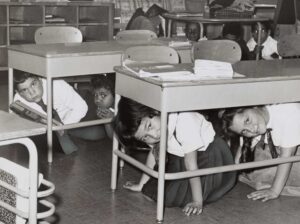 Journalist Jill Filipovic (profile here), who frequently writes op-eds for CNN, says here, “Making the prospect of nuclear war … a part of the international calculus in potential conflict” — which is what Russia’s Putin did this week — is “a startling departure … from more than 30 years of post-Cold War security.”
Journalist Jill Filipovic (profile here), who frequently writes op-eds for CNN, says here, “Making the prospect of nuclear war … a part of the international calculus in potential conflict” — which is what Russia’s Putin did this week — is “a startling departure … from more than 30 years of post-Cold War security.”
“For members of my generation” (she’s 39) “and those younger,” she continues, “the threat of nuclear war was a scary relic of bad times past.”
Then she says, “I don’t expect that nuclear drills will return to American schools,” and adds, “I’m pretty sure my older fellow Americans already know that desk you were hiding under wasn’t going to save you anyway.”
I don’t think she gets it.
I was in high school during the Cuban Missile Crisis and participated in those “duck and cover” drills. There also was a fallout shelter in the school building’s basement.
A nuclear explosion has three main effects: Thermal, blast, and radiation. Nuclear weapons are designed to explode above the target to maximize thermal and blast effects, which whether intended or not also minimizes radioactive fallout (I doubt Putin, were he to pull the trigger, would have that in mind).
If you’re inside the radius of the fireball, or very near it, there’s nothing more to discuss.
Duck-and-cover drills presuppose the school building is some distance from the target, where the immediate damage will be from blast effects. The greatest danger to the kids will be from flying glass, when the shock wave blows the windows inward. Another hazard is overhead light fixtures and ceiling tiles coming down. Using a desk as overhead cover provides some protection from both.
In a nuclear alert, school principals and teachers won’t tell the students to hide under their desks; they’ll lead them in groups to the shelter. You duck and cover only if attack is imminent or has occurred (the flash of the explosion arrives before the shock wave does), and there isn’t time to get to the shelter.
So, Filipovic’s insinuation that the duck-and-cover drills were pointless isn’t necessarily true. Using available cover to protect yourself from flying debris is common sense. School desks, as improvised cover, are a whole lot better than nothing as protection from flying glass shards and falling ceiling debris. (Of course, if the building collapses, that’s a different story.) You use that when there isn’t time to do anything else.
These drills simply trained kids to dive under the desk, instead of stand in front of the windows, gawking at the fireball (which is a really bad idea, but likely to be an untrained kid’s first reaction). That’s a really bad place to be when a bank of windows turns into 50,000 pieces of razor-sharp, high-velocity shrapnel.
One hopes, of course, that no generation of American kids will ever have to actually experience a nuclear war on home soil (or anywhere else, for that matter). But, human nature and past history of human conflict being what they are, I don’t take that for granted. Remember the Boy Scout motto? “Be prepared.” Teaching kids to duck and cover is a very simple, easy to teach, no-cost precaution.
Keeping in mind, of course, that if you’re not consumed by the fireball, and avoid serious blast injuries, the radiation may still get you; and if it doesn’t there’s a good chance that “nuclear winter” or competing for basic survival necessities like food in a post-apocalyptic world will. There are a lot of ways to die in a nuclear war and its aftermath, but being shredded by little flying glass knives isn’t one I’d choose.